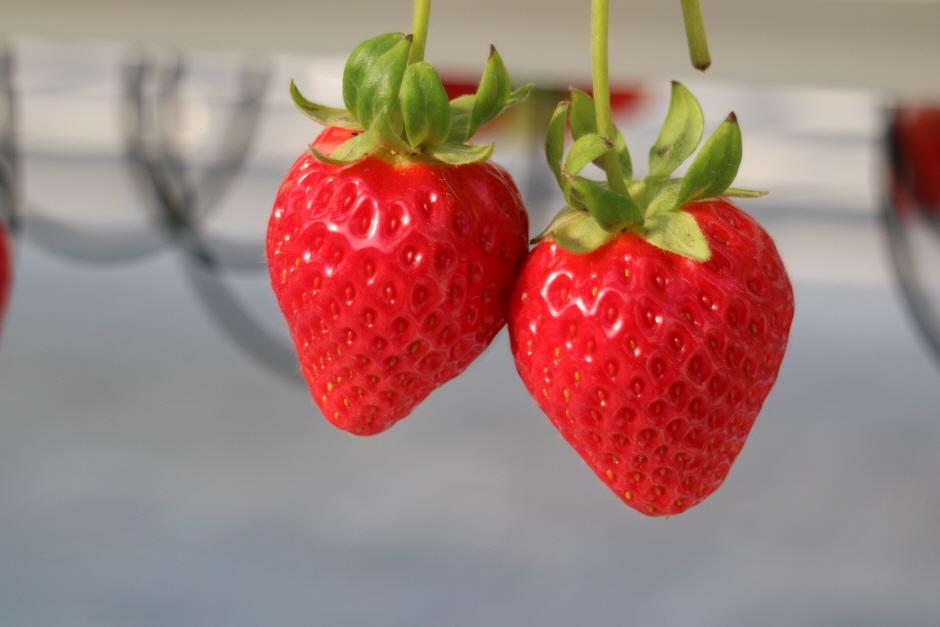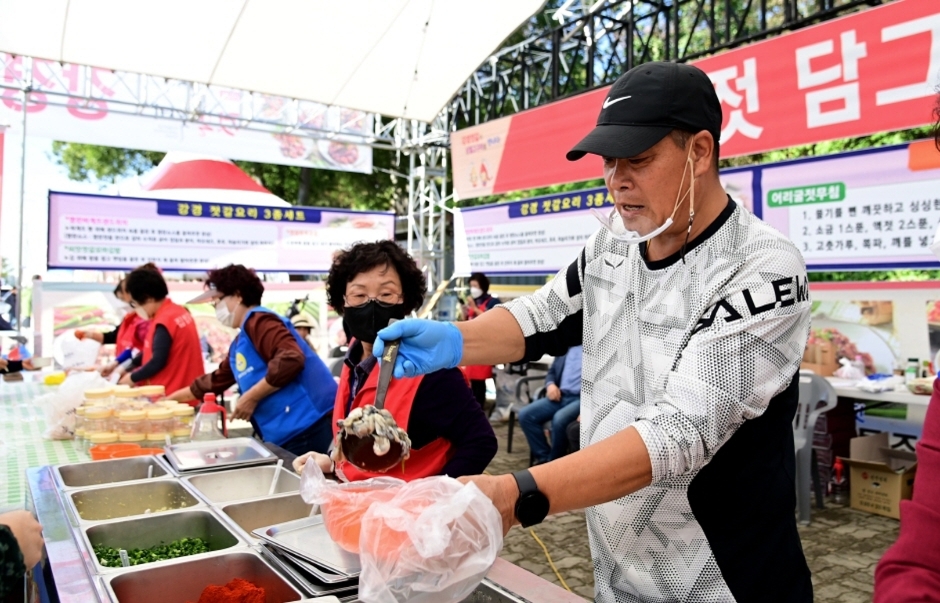Festival de la Fresa de Nonsan (논산딸기축제)
0m 2468 2024-01-30
Simin-ro 270, Nonsan-si, Chungcheongnam-do.
041-730-2983
El festival consiste en presentar las fresas coreanas, que son dulces y ricas en vitamina C. Se realiza en la ciudad de Nonsan, que es la primera productora de fresas del país. La primera edición del festival fue en 1997. Generalmente, el festival incluye degustación, exposición y venta de las fresas a precios económicos, con el fin de promocionar las fresas de Nonsan. También se puede participar en eventos relacionados con la preparación de la mermelada de fresa, la degustación gratuita del tteok (pastel de arroz) de fresa, etc. Suele abrirse además una feria de productos tradicionales de la región de Nonsan, espectáculo de fuegos artificiales, entre otros eventos.
Bonsuwon Wangsutbulgalbi (수원갈비)
1.3 Km 96 2016-09-05
Jungang-ro 410(sabaeksip)beon-gil 7-4, Nonsan-si, Chungcheongnam-do.
This restaurant is located at Meokjagolmok which is on the right side of Nonsan a cross-country bus terminal .Because it is built of wood and yellow earth, the inside is so warm and makes a traditional atmosphere. This restaurant accommodates 120 patrons and the kitchen and restroom are kept clean. All employee offer high quality service. Most of all , we can enjoy the abundant side dishes there.
Puente Colgante del Lago Tapjeong en Nonsan (논산 탑정호 출렁다리)
6.0 Km 0 2024-03-25
Jongyeon-ri 155, Gayagok-myeon, Nonsan-si, Chungcheongnam-do
Antigua Iglesia Metodista Seonggyeol de Ganggyeong (구 강경성결교회 예배당)
7.5 Km 22493 2021-07-08
Gyebaek-ro 219-beongil 40-1, Ganggyeong-eup, Nonsan-si, Chungcheongnam-do
En la primera época del protestantismo en Corea, las iglesias utilizaron, en su mayor parte, la arquitectura de estilo hanok (casas tradicionales coreanas). Pero, dado que muchos misioneros y líderes de la congregación religiosa eran occidentales, ellos se sentían incómodos al usar estos edificios, y empezaron a construir las iglesias de estilo occidental. En consecuencia, la mayoría de las iglesias de estilo coreano desaparecieron o fueron sometidas a obras de remodelación.
Sin embargo, la Iglesia Metodista Seonggyeol de Ganggyeong ha conservado su edificio original hasta la fecha, convirtiéndose en una estructura única y muy valiosa. Este edificio es considerado como un material importante para estudiar la transición tecnológica de lo tradicional a lo moderno.
Mercado del Jeotgal de Ganggyeong (강경젓갈시장)
7.9 Km 240 2024-01-23
Oknyeobong-ro 27-beongil 30-3, Ganggyeong-eup, Nonsan-si, Chungcheongnam-do
El Mercado del Jeotgal de Ganggyeong es el único mercado en Corea que conserva tradiciones relacionadas con el jeotgal, el pescado y los mariscos salados. La gamba salada toma media parte de la venta de todo el mercado de Corea. Se llena de visitantes desde junio hasta noviembre, bien antes de la temporada del kimchi.
Festival del Jeotgal de Ganggyeong en Nonsan (논산 강경젓갈축제)
8.4 Km 4580 2024-01-30
Geumbaek-ro 45, Nonsan-si, Chungcheongnam-do.
041-730-2973
El festival se realiza en Ganggyeong, la región en donde se encuentra el mercado de mariscos salados más grande de Corea. De esta manera, podrá conocer el ambiente peculiar de la aldea pesquera. Los pescados y mariscos salados de Ganggyeong, que poseen una tradición de 200 años, son famosos por su sabor fresco, fermentados científicamente según los métodos tradicionales. Se presentan varios platos preparados con estos productos, y entre los programas participativos, el más famoso para los turistas extranjeros, es el de preparar kimchi.
Evergreen Hotel (에버그린 관광호텔)
9.6 Km 8114 2020-03-30
369, Hwanghwa-ro, Nonsan-si, Chungcheongnam-do
+82-41-742-3344
Evergreen Hotel is the only tourist hotel in Nonsan. The hotel has 40 comfortable rooms and 2 banquet halls, a seminar room, coffee shop, live café, buffet, and sauna.
Myeongrjaegotaek [Korea Quality] / 논산 명재고택 [한국관광 품질인증]
10.6 Km 10549 2023-04-13
50, Noseongsanseong-gil, Noseong-myeon, Nonsan-si, Chungcheongnam-do
+82-41-735-1215, +82-10-6310-1139
Located in Noseong-myeon, Nonsan-si, Chungcheongnam-do, Myeongjae Historic House was built by Yun Jeung (pen-name: Myeongjae, 1629-1714), a scholar during the reign of King Sukjong (r. 1674-1720) of the Joseon Dynasty. It is said that although the king granted him a government post on eighteen occasions, Yun, being a straightforward sort of person, declined them all. As he practiced the virtue of simplicity and sharing in life and taught it to younger generations, the house escaped destruction during the Donghak Peasant Revolution (1894) and the Korean War (1950-1953) thanks to the efforts of his disciples. Thus, in keeping with his character, the house looks moderate compared to the homes of other aristocrats, although it exhibits a refined interior and a scientific design. The house consists of a sarangchae (men’s quarters), anchae (women’s quarters), and daecheongmaru (main floored room) configured in a square layout. The sarangchae itself consists of the keun sarangbang (large room) flanked by a daecheong and a numaru with an open view of the village and a mountain, the jakeun sarangbang (small room), the ansarangbang (inner room), and the daemungan (gate). To the right of the house is the spectacular sight created by a platform filled with hundreds of crocks for traditional sauces and condiments. The wall situated between the sarangchae and the anchae was designed to prevent people from looking into the anchae. There is also an open space below the wall from which one could see the shoes of a visitor, thus enabling the occupants of the anchae to know whether there was a visitor or not in the sarangchae. In addition, the gotganchae (storage quarters) situated next to the anchae is designed in such a way that it diminishes in size towards the north because the summer wind blowing from the south escapes the narrow passageway of the north, so it blows faster and the surrounding area gets colder, while the wind winter blowing from the north escapes the large passageway of the south, protecting the building from the bitter wind of the north. Therefore, the storeroom at the north end of the gotganchae remains cool even in summer, thereby preserving the things (food and other commodities) stored there. The guestrooms of the house include the three sarangbang rooms in the sarangchae building and the geonneonbang (a room opposite the main living room) in the anchae. The entire sarangchae building including the numaru can be rented too. Guests can also rent the thatched-roof byeolchae in the courtyard, which features a choyeondang equipped with a sound system and a beam projector, as well as a modern bathroom, for group meetings or performances. The house also runs a variety of paid traditional experience programs including Gukak (Korean classical music), tea ceremony, natural dyeing, and so on. Other noteworthy features of the house include the sarangchae’s distinctive gate, which combines a sliding door with a hinged door, the looming presence of a mountain to its rear, and the little round island (pond) planted with an old crape myrtle at its front.
Baek il heon Head House [Korea Quality] / 논산 백일헌 종택 [한국관광 품질인증]
11.0 Km 9208 2020-09-08
45, Jugok-gil, Sangwol-myeon, Nonsan-si, Chungcheongnam-do
+82-41-736-4166 / +82-10-2911-4166
The Baegilheon Head House (National Folklore Cultural Heritage No. 273) is the house that was bestowed upon General Yi Sam by King Yeongjo in recognition of his achievement in suppressing the Yi In-jwa Rebellion in 1728. King Yeongjo also granted Yi Sam the posthumous name ‘Baegilheon’. The house is composed of the munganchae (gate quarters) situated next to a tall gate, the ‘ㄷ’-shaped anchae (women’s quarters), and the ‘ㄱ’-shaped sarangchae (men’s quarters), which are configured in an overall square layout. The accommodation includes the munganchae, the araet sarang with a numaru (upper floor), and the wit sarang and the geonneotbang, each of which has a large toenmaru (a narrow wooden porch running along the outside of the building). Notably, the geonneotbang, which is connected with the daecheong (wooden floor) and has a cozy courtyard surrounded by a mud wall, was the living space for the eldest son of the family and his wife for many generations. As the house has been designated as a National Folklore Cultural Heritage, cooking in the guestrooms is strictly prohibited. However, the house provides breakfast prepared by the daughter-in-law of the head house free of charge. The toilets and shower room are situated in the back yard.
Fortaleza Naseong de Buyeo (부여 나성) [Patrimonio Cultural de la Humanidad de la Unesco]
15.6 Km 19419 2020-08-19
Dongmun-ro 142-beongil 100-11, Buyeo-eup, Buyeo-gun, Chungcheongnam-do.
La Fortaleza Naseong de Buyeo, también conocida como la Muralla Exterior de la Ciudad, fue construida para proteger la capital de Baekje, Sabi. Es una fortaleza de unos 84 kilómetros. La muralla alrededor de la Fortaleza Busosanseong rodea los exteriores de la ciudad.
La muralla es una de las más antiguas junto con la Fortaleza Naseong de Pyeongyang y se cree que fue construida en el año 538 cuando la capital fue trasladada desde Woonjin (actual Gongju) a Sabi (actual Buyeo). La muralla de la fortaleza empieza en el sitio donde se localizaba la Puerta Este (Dongmun), hacia el área del río Geumgang, de las que solo permanecen algunos restos.
Se pueden ver rastros de la fortaleza incluyendo el área este de la Fortaleza Cheongsanseong, el Puente Dongmun desde Seokmok-ri, y un área desde el pico Pilseobong hasta Yeomchang-ri. La muralla exterior tiene una considerable pendiente, mientras que el lado interior posee una suave pendiente que permitía ingresar a ella en caballo. Se pueden ver puestos de guardia en las partes más altas de la fortaleza. Dentro de ella se guarnecían el palacio de Baekje, los edificios gubernamentales, casas, templos y tiendas. Toda la estructura de la Fortaleza Naseong sigue el río Geumgang, en los lados sur y oeste de la ciudad, proveyendo una doble protección: natural y artificial.



![Myeongrjaegotaek [Korea Quality] / 논산 명재고택 [한국관광 품질인증]](http://tong.visitkorea.or.kr/cms/resource/40/1878940_image2_1.jpg)
![Baek il heon Head House [Korea Quality] / 논산 백일헌 종택 [한국관광 품질인증]](http://tong.visitkorea.or.kr/cms/resource/98/2530098_image2_1.jpg)
 Español
Español
 한국어
한국어 English
English 日本語
日本語 中文(简体)
中文(简体) Deutsch
Deutsch Français
Français Русский
Русский